
By Angelo Randaci, Earth’s Ally Horticulturist
Angelo’s passion for plants has led him to explore many areas of horticulture including research, grounds management, technical training, design and nursery management.
The Art of Plant Staking
Staking plants is an essential part of gardening. Nothing is more frustrating than to see a wave of vibrant blossoms at the peak of beauty fall over with broken stems or trampled blooms. Without plant supports, many plants will fall over from unforeseen factors such as strong winds, rains, animal traffic or plant stress. This can devastate your garden.
Staking plants simply means to support a plant by any number of methods. It’s the plants we want to see, not a slew of plant props. If plant stakes are the first thing you notice in your garden, then read on for ideas and tips on how to stake plants inconspicuously so the beauty of your plants shines through.
Types of Plant Support Stakes
Plant stakes fall into two basic categories: preventative and remedial. Preventative staking is providing supports to plants before they fall over. Remedial staking involves the repair of plants that have already flopped.
- Preventative Garden Stakes – Plants with large flowerheads will often fall over by their own weight or after heavy rains. Double peonies are a good example of this. Other plants with tall or heavily flowered stems are prone to falling over as well. Some examples are: delphiniums, foxgloves and hollyhocks. These flowering beauties will benefit from preventative measures before issues occur. Staking plants early, when they reach about half of their mature height, will provide support for the plant and allow the foliage to hide the stake as it grows.
- Remedial Garden Stakes – Remedial staking is more challenging because you are in repair mode. Broken stems will need to be pruned out along with bent over flower heads. It may be too late at this point to save the flower by staking it unless the stems have not broken. When you do stake them, the plant supports will be more conspicuous.
Plant Support Stakes Tips & Tricks
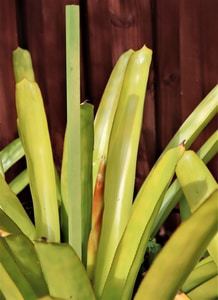
Regardless of methods,the key here is to stake your plants as inconspicuously as possible. Here are some tips on how to discreetly stake your plants.
The color of your garden stakes and ties is important. Paint the stake shades of green to match the foliage. Green Velcro ties are available that will work well with the added advantage that they can be adjusted as the plant grows.
Do not tie your plants too tightly. The plants naturally require movement from the wind to thicken the stems. Be sure your stakes are thick enough and tall enough to support your plants. The stake will need to go in at least 12”into the ground to hold your plants upright. Keep extra stakes on hand for remedial staking or to add to existing stakes to reinforce your plants.
Things you can do to avoid having to stake your plants:
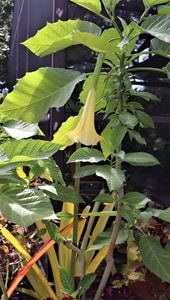
- Description automatically generated with low confidence”>Develop a good garden soil with plenty of organic matter. This allows plants roots to grow deep and helps anchor them in the soil.
- Use proper spacing for your plants. Plants planted too close may stretch for light and develop weak stems.
- Pruning certain plants early in the season will keep them at a shorter height and make them bushier.
- Practice “right plant right place.” Choose plants that will thrive in the conditions you have. Sun plants planted in too much shade will stretch and fall over from weak stems. Shade plants may be stunted or even burned from too much sun.
- Some plants will fall over naturally, then turn upwards again interweaving between other plants and appear to travel around the garden. There is nothing wrong with this because it adds a natural element to the design.
Garden Staking Methods

A simple inexpensive way to make plant stakes is torip fencing boards into 1/2” strips andcut them to desired lengths. Oftentimes you can use an existing support to attach ties to your plants. This could be a hook, nail, or pipe that is already on your house. Attach your plants to a wall using self-adhesive anchors. Anchors are available that do not harm the surface; attach plants to a nearby garden ornament or trellis if you can.

Use one stake to attach multiple stems. Drive a stake into the ground behind the plant or hidden in the middle; tie each stem to the stake separately like the spokes of a wheel. Chicken wire is one of the best methods of supporting plants like peony or Baptisia australis. Place a square of chicken wire over your peony plants when the shoots first emerge from the ground in the spring. As the stems grow, they will raise the chicken wire off the ground. The chicken wire becomes invisible when the plants mature and flower. Use flags or some type of marker to identify yet to emerge plantsso you don’t step on them until they become obvious; you can write the name of the plant on the flags as a marker. This also prevents you from accidently pulling out a plant thinking it is a weed. Why not use a decorative garden stake to add color, beauty and whimsy to your garden? Plant stakes are available that add a vibrant spectrum of interest and color to your garden.
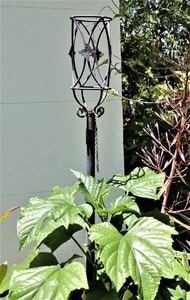
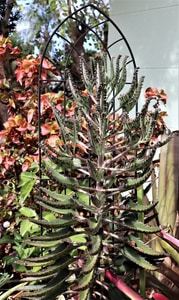
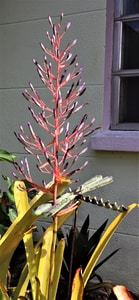
We’d love to hear how the Earth’s Ally blog is helping you grow healthy plants. Share your experience and stay connected with the #EarthsAlly community on Facebook, Instagram and Twitter for access to our latest blog posts, giveaways and exclusive promotions.
